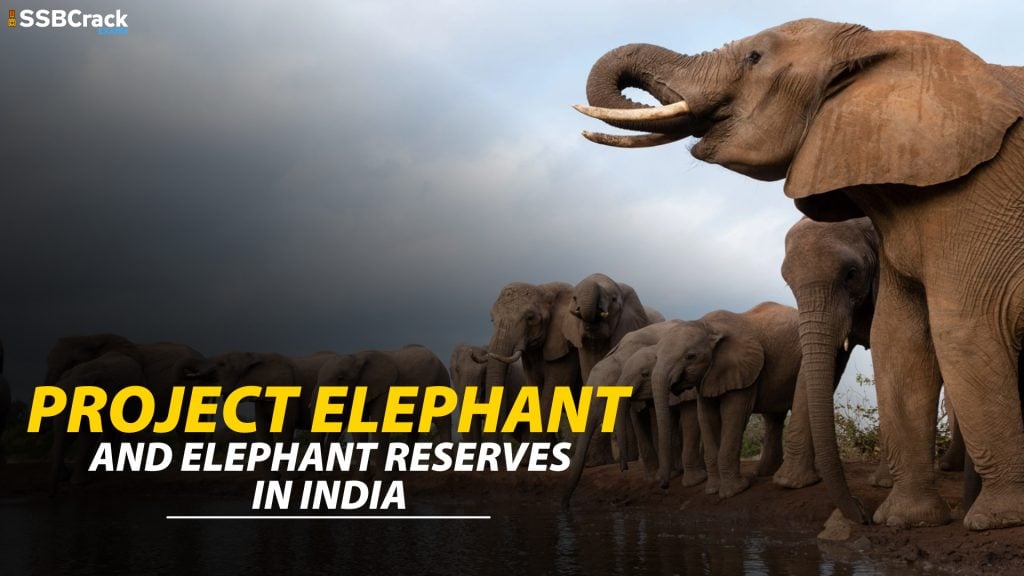
Greetings future warriors today we are going to discuss about Project Elephants. The topics we are going to cover are:
- About Indian Elephants
- Importance of Elephants
- National Heritage Animal of India
- Elephant Corridors
- Threats to Elephant Corridors
- Project Elephant
- Objectives
- List of Elephant Reserves
- Map of Elephant Reserves
So let’s start with our discussion
About Indian Elephants
- Status: Endangered (means “A species considered to be facing a very high risk of extinction in the wild”)
- Population: 20,000 – 25,000
- Scientific Name: Elephas maximus indicus
- Height: 6-11 feet at the shoulder
- Length: Up to 21 feet
- Weight: 5 tons
- Habitats: Subtropical broadleaf forest, tropical broadleaf moist forest, dry forest, grassland
- Number of Elephants in India: All-India Elephant Population Estimation (2017) pegs India’s Asian elephant population at 27,312. According to the report, released by the Ministry of Environment, Forests and Climate Change, Karnataka has the highest number of elephants (6,049), followed by Assam (5,719) and Kerala (3,054).
Importance of Elephants
- Elephants are not only a cultural icon in India and throughout Asia, they also help to maintain the integrity of their forest and grassland habitats.
- Elephants are among the most intelligent of the creatures with whom we share the planet, with complex consciousnesses that are capable of strong emotions.
- During the dry season, elephants use their tusks to dig for water. This not only allows the elephants to survive in dry environments and when droughts strike, but also provides water for other animals that share harsh habitats.
- When forest elephants eat, they create gaps in the vegetation. These gaps allow new plants to grow and create pathways for other smaller animals to use. They are also one of the major ways in which trees disperse their seeds; some species rely entirely upon elephants for seed dispersal.
- On the savannahs, elephants feeding on tree sprouts and shrubs help to keep the plains open and able to support the plains game that inhabit these ecosystems.
- Wherever they live, elephants leave dung that is full of seeds from the many plants they eat. When this dung is deposited the seeds are sown and grow into new grasses, bushes and trees, boosting the health of the savannah ecosystem.
National Heritage Animal of India:
- The elephant has been declared as the national heritage animal by the government of India in 2010 after the recommendations of the standing committee on national board for wildlife. This was to ensure sufficient protection for elephants before it’s numbered fall to panic levels as it had happened in case of tigers.
- A proposed National elephant conservation authority (NECA) on the lines with NTCA has been proposed to be constituted by amending the Wildlife Protection Act 1972.
Elephant Corridors
- Elephant corridor is the narrow strips of forested lands which connects larger elephant habitats with significant elephant populations. It acts as a conduit for the movement of elephants between the elephant habitat. It is necessary to enhance species survival and birth rate of the elephant population in the wild.
- There are around 88 elephant corridors in India out of which 20 are in South India, 12 in North Western India, 14 in North West Bengal, 20 in Central India and 22 in North Eastern India. About 77.3% of these corridors are regularly used by the elephants. One-third of these corridors are of high ecological priority and other two third are of medium priority.
Threats to Elephant Corridors:
- Problems such as elephant habitat loss which is leading to fragmentation and destruction primarily due to developmental activities such as the construction of roads, railways, buildings, holiday resorts and electric fencing etc.
- Mining activities such as coal mining and iron ore mining have been described as single biggest threats to elephant corridor in Central India. States like Jharkhand, Chhattisgarh and Orissa are mineral rich but also have the highest number of elephant corridors which is leading to elephant man conflict.
- As elephants require extensive grazing ground for food, lack of such grazing grounds can force elephants to search for food elsewhere. Most of the elephant reserves unable to accommodate all the elephants, which results in man-elephant conflict due to the destruction of crops by elephants
- Tiger faces threat of extinction whereas elephant faces threat of attrition. The elephant numbers have not increased or decreased but there is an increasing pressure on the elephant habitats.
Project Elephant
- Project elephant is a centrally sponsored scheme launched in February 1992. The scheme helps and assists in the management and protection of elephants to the States having free-ranging populations of wild elephants, in order to ensure the survival of elephant population in the wild and protection of elephant habitat and elephant corridor.
- Project elephant is mainly implemented in 16 States / UTs, which includes Andhra Pradesh, Arunachal Pradesh, Assam, Jharkhand, Kerala, Nagaland, Meghalaya, Karnataka, Tamil Nadu, Uttar Pradesh, Orissa, Uttaranchal West Bengal Maharashtra and Chhattisgarh.
- The union government provides financial and technical assistance to the states to achieve the goals of this project. Help is also provided for the purpose of the census, training of field officials and to ensure the mitigation and prevention of human-elephant conflict.
- There are around 32 elephant Reserves in India notified by the state governments. The first elephant reserve was the Singhbhum elephant Reserve of Jharkhand.
Objectives:
- Assist states having populations of wild elephants and to ensure long term survival of identified viable populations of elephants in their natural habitats
- Addressing man animal conflict.
- Developing scientific and planned management measures for conservation of elephants.
- Protecting the elephants from poachers, preventing illegal ivory trade and unnatural causes of death
List of Elephant Reserves
In the tables below is the official list of all the elephant reserves in India (A total of 32).


Map of Elephant Reserves

The readers can subscribe to SSBCrackExams to get more informative articles in their feed. All the best.
Also Read:
- Types Of Wind – UPSC CDS NDA Geography Notes
- Classification Of Soil In India – Types Of Soil In India
- List Of Geographical Indications [GI Tags] In India
- List Of Biosphere Reserves In India
- List Of National Parks In India
- List Of Dams In India [Highest, Longest, Largest, Oldest & State-Wise List]
- List Of Tiger Reserves In India



















